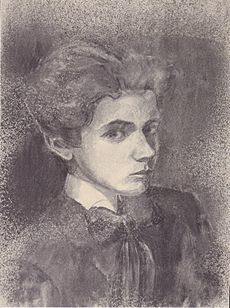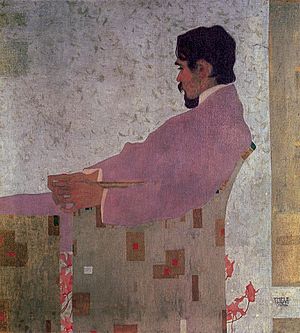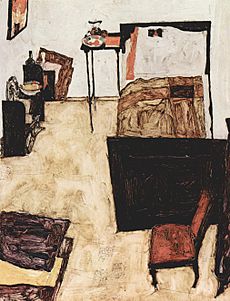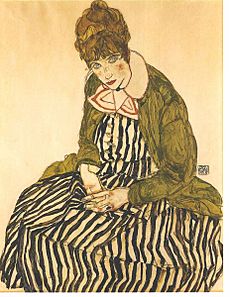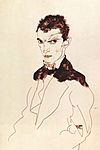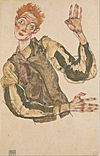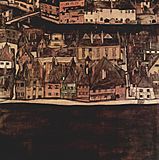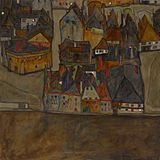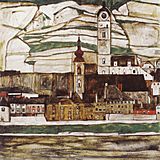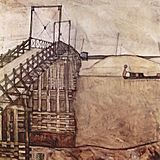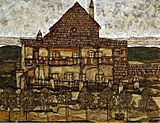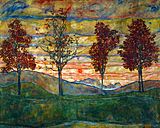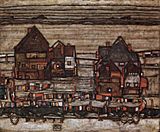Egon Schiele facts for kids
Quick facts for kids
Egon Schiele
|
|
|---|---|

Photograph of Egon Schiele, 1910s
|
|
| Born | 12 June 1890 Tulln an der Donau, Austro-Hungarian Empire
|
| Died | 31 October 1918 (aged 28) |
| Nationality | Austrian |
| Education | Akademie der Bildenden Künste |
| Known for | Painting, drawing, printmaking |
|
Notable work
|
|
| Movement | Expressionism |
Egon Leo Adolf Ludwig Schiele ( 12 June 1890 – 31 October 1918) was an Austrian Expressionist painter.
Contents
Biography
Early life
Schiele was born in 1890 in Tulln, Lower Austria. His father, Adolf Schiele, the station master of the Tulln station in the Austrian State Railways, was born in 1851 in Vienna to Karl Ludwig Schiele, a German from Ballenstedt and Aloisia Schimak; Egon Schiele's mother Marie, née Soukup, was born in 1861 in Český Krumlov (Krumau) to Franz Soukup, a Czech father from Mirkovice, and Aloisia Poferl, a German Bohemian mother from Český Krumlov. As a child, Schiele was fascinated by trains, and would spend many hours drawing them, to the point where his father felt obliged to destroy his sketchbooks. When he was 11 years old, Schiele moved to the nearby city of Krems (and later to Klosterneuburg) to attend secondary school. To those around him, Schiele was regarded as a strange child. Shy and reserved, he did poorly at school except in athletics and drawing.
Academy of Fine Arts
When Schiele was 14 years old, his father died, and he became a ward of his maternal uncle, Leopold Czihaczek, also a railway official. Although he wanted Schiele to follow in his footsteps, and was distressed at his lack of interest in academia, he recognised Schiele's talent for drawing and unenthusiastically allowed him a tutor, the artist Ludwig Karl Strauch. In 1906 Schiele applied at the Kunstgewerbeschule (School of Arts and Crafts) in Vienna, where Gustav Klimt had once studied. Within his first year there, Schiele was sent, at the insistence of several faculty members, to the more traditional Akademie der Bildenden Künste in Vienna in 1906. His main teacher at the academy was Christian Griepenkerl, a painter whose strict doctrine and ultra-conservative style frustrated and dissatisfied Schiele and his fellow students so much that he left three years later.
Klimt and first exhibitions
In 1907, Schiele sought out Gustav Klimt, who generously mentored younger artists. Klimt took a particular interest in the young Schiele, buying his drawings, offering to exchange them for some of his own, arranging models for him and introducing him to potential patrons.
Schiele's earliest works between 1907 and 1909 contain strong similarities with those of Klimt, as well as influences from Art Nouveau. In 1908 Schiele had his first exhibition, in Klosterneuburg. Schiele left the Academy in 1909, after completing his third year, and founded the Neukunstgruppe ("New Art Group") with other dissatisfied students. In his early years, Schiele was strongly influenced by Klimt and Kokoschka.
Schiele participated in numerous group exhibitions, including those of the Neukunstgruppe in Prague in 1910 and Budapest in 1912; the Sonderbund, Cologne, in 1912; and several Secessionist shows in Munich, beginning in 1911. In 1911, Schiele met the seventeen-year-old Walburga (Wally) Neuzil, who lived with him in Vienna and served as a model for some of his most striking paintings. Very little is known of her, except that she had previously modelled for Gustav Klimt.
World War I to death
In 1914, Schiele glimpsed the sisters Edith and Adéle Harms, who lived with their parents across the street from his studio in the Viennese district of Hietzing, 101 Hietzinger Hauptstraße. They were a middle-class family and Protestant by faith; their father was a master locksmith. In 1915, Schiele chose to marry the more socially acceptable Edith. Despite some opposition from the Harms family, Schiele and Edith were married on 17 June 1915, the anniversary of the wedding of Schiele's parents.
Although Schiele avoided conscription for almost a year, World War I now began to shape his life and work. Three days after his wedding, Schiele was ordered to report for active service in the army where he was initially stationed in Prague.
During the war, Schiele's paintings became larger and more detailed. His military service, however, gave him limited time, and much of his output consisted of linear drawings of scenery and military officers. Around this time, Schiele also began experimenting with the themes of motherhood and family. His wife Edith was the model for most of his female figures, but during the war (due to circumstance) many of his sitters were male.
Despite his military service, Schiele was still exhibiting in Berlin. He also had successful shows in Zürich, Prague, and Dresden. His first duties consisted of guarding and escorting Russian prisoners. Because of his weak heart and his excellent handwriting, Schiele was eventually given a job as a clerk in a POW camp near the town of Mühling. There, he was allowed to draw and paint imprisoned Russian officers; his commander, Karl Moser (who assumed that Schiele was a painter and decorator when he first met him), even gave him a disused store room to use as a studio. Since Schiele was in charge of the food stores in the camp, he and Edith could enjoy food beyond rations.
By 1917, he was back in Vienna and able to focus on his artistic career. His output was prolific, and his work reflected the maturity of an artist in full command of his talents. He was invited to participate in the Secession's 49th exhibition, held in Vienna in 1918. Schiele had fifty works accepted for this exhibition, and they were displayed in the main hall. He also designed a poster for the exhibition; it was reminiscent of the Last Supper, with a portrait of himself in the place of Christ. The show was a triumphant success. As a result, prices for Schiele's drawings increased and he received many portrait commissions.
In the autumn of 1918, the Spanish flu pandemic reached Vienna. Edith, who was six months pregnant, died from the disease on 28 October. Schiele died only three days after his wife. He was 28 years old. During the three days between their deaths, Schiele drew a few sketches of Edith.
Art collections
The Leopold Museum, Vienna houses perhaps Schiele's most important and complete collection of work, featuring over 200 exhibits. The museum sold one of these, Houses With Colorful Laundry (Suburb II), for $40.1 million at Sotheby's in 2011. Other notable collections of Schiele's art include the Egon Schiele-Museum, Tulln, the Österreichische Galerie Belvedere, and the Albertina Graphic Collection, both in Vienna. Viktor Fogarassy collected works by Schiele, including Dämmernde Stadt.
Self-portraits
Landscapes
Images for kids
See also
 In Spanish: Egon Schiele para niños
In Spanish: Egon Schiele para niños


